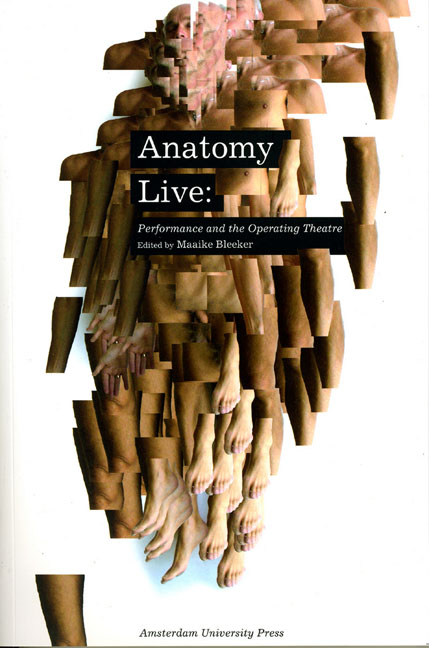Book contents
- Frontmatter
- Contents
- Acknowledgements
- Prologue - Men with Glass Bodies
- Introduction
- Performance Documentation 1: Holoman; Digital Cadaver
- Digital Cadavers and Virtual Dissection
- ‘Who Were You?’: The Visible and the Visceral
- Performance Documentation 2: Excavations: Fresh but Rotten
- The Anatomy Lesson of Professor Moxham
- ‘Be not Faithless But Believing’: Illusion and Doubt in the Anatomy Theatre
- Performance Documentation 3: De Anatomische Les
- Of Dissection and Technologies of Culture in Actor Training Programs – an Example from 1960s West Germany
- Ocular Anatomy, Chiasm, and Theatre Architecture as a Material Phenomenology in Early Modern Europe
- Performance Documentation 4: Camillo – Memo 4.0: The Cabinet of Memories – A Tear Donnor Session
- Martin, Massumi, and the Matrix
- Performance Documentation 5: Sensing Presence no 1: Performing a Hyperlink System
- ‘Where Are You Now?’: Locating the Body in Contemporary Performance
- Performance Documentation 6: Under My Skin
- Anatomies of Live Art
- Performance Documentation 7: Crash
- Restaging the Monstrous
- Delirium of the Flesh: ‘All the Dead Voices’ in the Space of the Now
- Performance Documentation 8: Körper
- Operating Theatres: Body-bits and a Post-apartheid Aesthetics
- Index
Operating Theatres: Body-bits and a Post-apartheid Aesthetics
Published online by Cambridge University Press: 10 February 2021
- Frontmatter
- Contents
- Acknowledgements
- Prologue - Men with Glass Bodies
- Introduction
- Performance Documentation 1: Holoman; Digital Cadaver
- Digital Cadavers and Virtual Dissection
- ‘Who Were You?’: The Visible and the Visceral
- Performance Documentation 2: Excavations: Fresh but Rotten
- The Anatomy Lesson of Professor Moxham
- ‘Be not Faithless But Believing’: Illusion and Doubt in the Anatomy Theatre
- Performance Documentation 3: De Anatomische Les
- Of Dissection and Technologies of Culture in Actor Training Programs – an Example from 1960s West Germany
- Ocular Anatomy, Chiasm, and Theatre Architecture as a Material Phenomenology in Early Modern Europe
- Performance Documentation 4: Camillo – Memo 4.0: The Cabinet of Memories – A Tear Donnor Session
- Martin, Massumi, and the Matrix
- Performance Documentation 5: Sensing Presence no 1: Performing a Hyperlink System
- ‘Where Are You Now?’: Locating the Body in Contemporary Performance
- Performance Documentation 6: Under My Skin
- Anatomies of Live Art
- Performance Documentation 7: Crash
- Restaging the Monstrous
- Delirium of the Flesh: ‘All the Dead Voices’ in the Space of the Now
- Performance Documentation 8: Körper
- Operating Theatres: Body-bits and a Post-apartheid Aesthetics
- Index
Summary
During the Renaissance, as Jonathan Sawday (1995) argues, the operating theatre provided a frame and lens for examining the society of death, crime, sexual politics, class, and medical knowledge. In this model, an operating theatre could be designed to detach organs from a body in order to perpetuate or produce systems and hierarchies of knowledge. Taking an eye, for instance, a structure of optics dissected from its jelly-like orb will inform the notion of a perspectival view and the lens of the camera, while later systems of power will reassemble the dismembered eyeball in the surveillance camera and the endoscope. It could be argued therefore that the anatomical body had little of absolute value since what became significant was its bit-like propensity for connectivity with other objects, mechanisms and beliefs in an historical situation. Further historicization of the anatomical body, so presciently examined by Sawday as a way of seeing the world, has complex implications for modernity and its history of colonization. One is that the history of modern states and their body politics are already located within a specular regime based on dissection.
In this essay, I want to consider how the bits of bodies that appear in ‘operating theatres ‘ connect to political and aesthetic structures, particularly those of a postcolonial situation. I intend to examine ‘body-bits’ as objects that are tied to a ‘landscape-like’ reshaping of theatrical form. The restaging of Monteverdi 's 1640 opera Il Ritorno d’Ulisse by Handspring Puppet Company in association with visual artist William Kentridge has particular resonance for this discussion. Post-apartheid South Africa, like much of the ‘postcolony’ of Africa, exists in a ‘phenomenology of violence’, in which human life expectancy is low (Mbembe, 2001, p. 173). Blacks, coloureds and whites still live at stratified distances from one another, and street violence is an everyday reality. In this landscape, different bodies have different life expectancies and thus varied access to medical care or legal rights. On a daily basis postcolonial subjectivity contends with the fragmentation, hybridity and differentiation of time and space left by colonial history, but I want to suggest that contemporary theatre does not merely replicate this fragmentation and hybridity.
- Type
- Chapter
- Information
- Anatomy LivePerformance and the Operating Theatre, pp. 251 - 262Publisher: Amsterdam University PressPrint publication year: 2008



